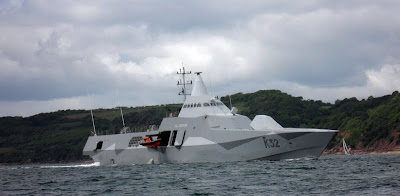We went for a sail today, me and Arwen that is. The winds were north-westerlies, force 4 with gusts to 30 knots. I wanted to go up the Tamar but the winds just howled straight down the channel making it a no go zone!
So I pottered around the sound. Actually I did some racing between buoys and tried to improve my times. Then I tried tacking under just main and mizzen. I still need to get the hang of tacking without a jib. That mizzen causes me so many problems because I just don’t seem to use it right!
Then I escorted HMS Bulwark out to sea. HMS Bulwark, is the second of a new class of assault ship and she was launched at the BAE Systems shipyard at Barrow-in-Furness on 15 November 2001. Formally commissioned into the Royal Navy on 28 April 2005, HMS Bulwark underwent a major 8 month refit and began 2011 undergoing sea trials and evaluations in order to return to the Fleet in February. She then undertook sea training to ensure that the ship and crew were ready in all respects to take over as the Royal Navy’s, high readiness, Flag Ship. So I guess this is one of her new deployments since then and so I waved her off and wished her luck. She’s a Devonport ship and we are a loyal lot here in Plymouth. We are a Royal Navy/Royal Marine city and proud of it too.
Having bashed up and down the sound for a bit, I then hove to so as to take a closer look at this wee beastie below.
I don’t know what nationality she is, I’m going with German. She looks fast, radar proof and somewhat stealth like. She’s bristling with machine guns and the two crew in combat gear looked very ‘professional and capable’ on the back decks. She dropped her rib out the side which then dashed off towards the Dockyard and she held station off the back of Drakes Island.
It made an unusual encounter to end the morning’s sail.
Steve
So I pottered around the sound. Actually I did some racing between buoys and tried to improve my times. Then I tried tacking under just main and mizzen. I still need to get the hang of tacking without a jib. That mizzen causes me so many problems because I just don’t seem to use it right!
Then I escorted HMS Bulwark out to sea. HMS Bulwark, is the second of a new class of assault ship and she was launched at the BAE Systems shipyard at Barrow-in-Furness on 15 November 2001. Formally commissioned into the Royal Navy on 28 April 2005, HMS Bulwark underwent a major 8 month refit and began 2011 undergoing sea trials and evaluations in order to return to the Fleet in February. She then undertook sea training to ensure that the ship and crew were ready in all respects to take over as the Royal Navy’s, high readiness, Flag Ship. So I guess this is one of her new deployments since then and so I waved her off and wished her luck. She’s a Devonport ship and we are a loyal lot here in Plymouth. We are a Royal Navy/Royal Marine city and proud of it too.
Having bashed up and down the sound for a bit, I then hove to so as to take a closer look at this wee beastie below.
I don’t know what nationality she is, I’m going with German. She looks fast, radar proof and somewhat stealth like. She’s bristling with machine guns and the two crew in combat gear looked very ‘professional and capable’ on the back decks. She dropped her rib out the side which then dashed off towards the Dockyard and she held station off the back of Drakes Island.
It made an unusual encounter to end the morning’s sail.
Steve







































































